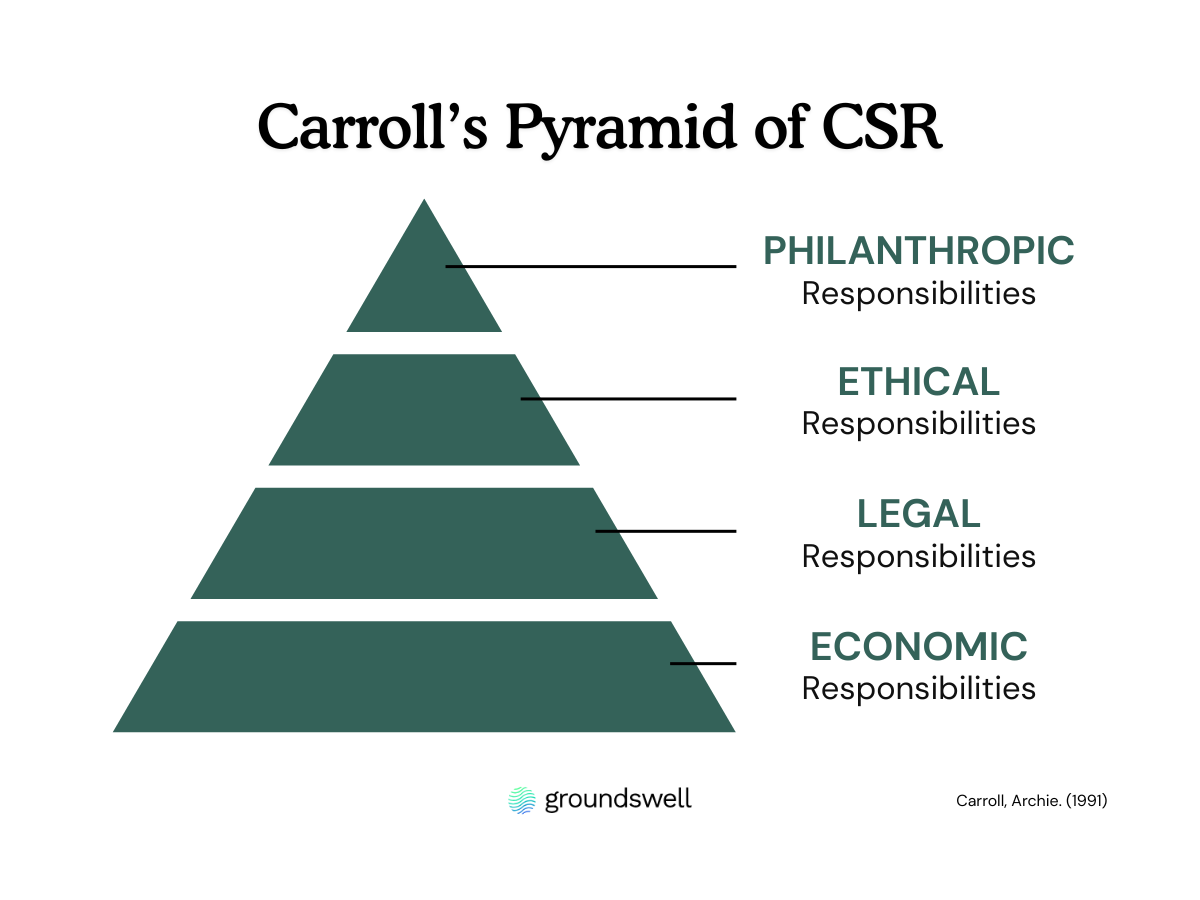Understanding the Pyramid of Corporate Social Responsibility: How It Shapes CSR Strategy

A few decades ago—between five and seven, depending on who you ask—a serious discussion began about corporations’ role in their communities and the world at large. It became clear that much of the public expected more from large companies than simply pursuing the profit motive.
To help companies assess their capabilities to embrace a CSR strategy, a leading business professor at the University of Georgia, Archie Carroll, devised what he called the pyramid of corporate social responsibility (CSR). Since its establishment in 1991, it’s helped many businesses create plans for meeting their obligations to various internal and external stakeholders.
Below, we’ll take a look at what the pyramid is, how it’s affected our modern definition of CSR, and how its logic can help you build effective programs for your organization.
Table of Contents:
- An Overview of the Four Layers: Economic, Legal, Ethical, and Philanthropic
- What Carroll’s CSR Pyramid Means for Your Company
- Groundswell Can Help You Execute Your CSR Strategy
An Overview of the Four Layers: Economic, Legal, Ethical, and Philanthropic
Carroll’s pyramid of corporate social responsibility has four distinct pillars, or layers, that describe businesses’ needs: economic, legal, ethical, and philanthropic. Each successive pillar builds upon the foundation of the previous one, similar to Maslow’s Hierarchy of Needs (you may recognize that one from Psychology 101 if you ever took it in college).

Below are detailed descriptions of the four pillars, along with real-world applications to illustrate the utility of each one.
1. Economic
The bottom layer—also the most fundamental—is the one that signifies economic responsibilities. A company’s simplest economic responsibility is to earn revenue through offering a useful product or service. Assuming companies turn that revenue into profit, employees get paid and have purchasing power themselves.
We understand that’s basic stuff, but it’s worth emphasizing that a company’s foremost duty (within the bounds of the law) is to make enough money to survive. Without fulfilling its basic economic and fiduciary duties, a company cannot execute CSR programs.
Economic Pillar in Action
Ensuring a business stays profitable requires careful planning from higher-ups. Executives must create scalable operations for long-term stability and adapt to macroeconomic trends. This involves making some hard decisions along the way, such as layoffs, but transparency and fair severance packages can help soften the blow.
2. Legal
Making a profit isn’t a company’s only fundamental duty. In civilized societies, constituents agree to abide by codified laws—many of which punish bad behavior. Through this framework, operating outside the law can make companies become unprofitable through fines and sanctions. Many people argue that the legal pillar, which Carroll placed second-from-lowest in his pyramid of corporate social responsibility, should be the lowest, most fundamental layer.
Legal Pillar in Action
From the beginning, companies have statutory obligations to various state and federal agencies. Corporations in the U.S. must file articles of incorporation with their respective Secretary of State office and submit yearly financial reports. Business operations must also respect applicable environmental regulations, such as the Clean Air Act and the Endangered Species Act, that are created and enforced by federal agencies. Additionally, financial executives must comply with data collection laws, an ever-important legal area for businesses.
3. Ethical
The decision to abide by laws is also an ethical one for companies, but the governments of the world have yet to codify into law every principle that the majority of people would consider to be ethical.
For instance, companies in the U.S. were generally free to discriminate based on a person’s race, ethnicity, religion, or gender. We now have a variety of laws to prevent discrimination against protected classes, but the vast majority of people also consider it ethical not to discriminate. Many unethical or immoral business practices are not prohibited by law, but companies can receive massive public blowback from ignoring widely held social mores.
Ethical Pillar in Action
Many companies that sell cosmetic products have pledged not to test on animals, which is still permitted in some parts of the world and is not explicitly banned in the U.S. Another area in ethics that companies are starting to pay attention to is sustainability. Some manufacturers have discovered that closed-loop systems that are kinder to Mother Earth can also enhance their profitability.
4. Philanthropic
The fourth and highest level, philanthropic, most closely resembles the accepted definition of corporate social responsibility. A philanthropic company goes beyond ethics and its legal obligations to provide charity, often in the form of monetary contributions, to worthy nonprofits. In other cases, companies can empower employees to donate their own money or time in the pursuit of charity. The philanthropic pillar, more so than the ethical pillar, involves proactivity on the part of companies rather than reactivity.
Philanthropic Pillar in Action
A simple example of a company satisfying the philanthropic layer would be donations to charities in that company’s community, such as animal shelters, soup kitchens, or shelters for the unhoused. Another example would be accountants and tax professionals providing reduced or no-cost tax filing services to disadvantaged individuals.
What Carroll’s CSR Pyramid Means for Your Programs
The pyramid of social responsibility is meant to be a loose framework through which executives can create a more detailed plan for becoming good corporate citizens. Many companies, especially in the early stages, only have the capacity to fulfill their economic and legal obligations, although many would argue that ethics is another non-negotiable for any business.
Groundswell Can Help You Execute Your CSR Strategy
While more and more companies are finding that the ethical and philanthropic pillars are vital to competing in today’s economy, many feel they lack the capacity to fulfill their CSR potential. That’s where a company like Groundswell can come in handy.
Our company is founded upon the idea that companies of all sizes can establish effective and impactful CSR programs. We provide an easy-to-use CSR software that:
- Instantly matches donations from employees and offers year-round giving and focused giving campaigns
- Distributes charitable donations and company matches to nonprofits within 24 hours
- Makes it easy to create and manage volunteer programs from any location
- Helps employees use tax-advantaged donation vehicles like donor-advised funds (DAFs)
- Offers the only integrated employee assistance fund (EAF) to provide financial stability for workers experiencing temporary hardship
- Simplifies and streamlines the grantmaking/grant application process in one unified platform
If that all sounds like a lot, don’t worry—we designed the software to consolidate and, in many cases, eliminate administrative burdens.
The next step? Get in touch with our team for a personalized demo. We look forward to showing how easy our software really is—and how your company can achieve its higher purpose you’ve been thinking about.
Related resources
How Do I Create an Employee Volunteer Program? 4 Steps for Success




How Do I Create an Employee Volunteer Program? 4 Steps for Success
24 Corporate Social Responsibility Statistics for Teams & Leaders




24 Corporate Social Responsibility Statistics for Teams & Leaders
Understanding Impact: 5 KPIs to Track for Effective Grants Management




